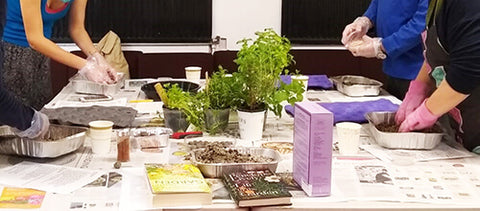Rhino Greenhouse – growing green and connecting with nature
When I cast my mind back to one particular day in June 2019, I remember its significance for two reasons. The date was Thursday 14th June. My partner and I were attending Gardeners’ World Live. On that day, my dream of owning a greenhouse came true when we decided to buy our Rhino after standing inside one in the exhibition hall. Up to that point, I had previously thought that our garden was too small to accommodate a greenhouse. The dream purchase was quickly followed by my second dream come true: asking my hero Mr. Montague Don a question about his trips to Japan, in a live Q&A session. I’ll come back to the Japan bit in a minute, but I almost forgot to mention that I also bought a delicious Italian chocolate gelato that day (I am a HUUUUUGE ice cream fan!).
Gardening has a massive significance to me on so many levels. As an occupational therapist (O.T.), I have specialised and been trained to understand the complexities and science behind the therapeutic benefits of occupation/activity. Basically, O.Ts believe that being meaningfully and purposefully occupied keeps people mentally and physically well. I caught the gardening bug during a teaching module on my OT (BSc) degree course and have been hooked ever since.
Right now, the thing that most fascinates me, is how gardening and nature can be used to facilitate a feeling of connection and connectedness that sometimes feels missing for many of us, both on a personal and community level. I’ve also become increasingly aware that, when looking to other cultures, we can be reminded of what’s important and what’s not. That nothing is permanent and everything changes. That nothing and no one is perfect - in fact, there is a beauty in imperfection. This is where Japanese culture in particular, its planting styles and Zen philosophy, can teach us so much to help rebalance and to repair the sense of disconnection and loneliness that many of us feel.
In some of my community workshops in the New Year, I will be teaching the art of kokedama (meaning ‘moss ball’). Kokedama are potless plants, which are sometimes grouped together and hung in a string garden. They are often referred to as the ‘poor man’s bonsai’, maybe because the idea developed from the Bonsai style of planting. Along with their natural beauty, what I love about the kokedama is the fact that they don’t look pristine and perfect…in fact that’s their charm. Since it’s wrapped in live sheet moss, the kokedama’s exterior constantly changes along with the plant contained within it. I love the symbolism and parallel of an imperfect plant and an imperfect human with flaws and weaknesses. A plant that’s constantly changing on the outside and inside, just as we as humans do.
In keeping with the Japanese theme, I will also be including (a very simplified version) of a Japanese tea ceremony. I’m working on the theory that the ritual and tranquillity embodied within this ceremony will help group participants be able to switch off from everyday demands and be ‘present’ as they embark on learning the skill of making kokedama.

Preparing for workshops:
Part of working as an occupational therapist means that I always need to anticipate the needs of my clients by analysing each activity for its demands. For example, making a kokedama needs the use of two hands and a good shoulder, arm and hand function, in order to complete all the tasks involved in the activity. Many long-term medical conditions and disability could cause a participant to struggle with this activity, so I want to anticipate some of these barriers by thinking of ways that the activity can be made adapted and made easier.

The Greenhouse as Therapy for a Therapy Professional:
It’s true to say that there’s a lot of thought that goes in to preparing for my workshops as well as reflecting afterwards on how they have gone and what needs to be changed. When working alongside participants, I often become a confidant for their most personal stories. In previous roles, I became acutely aware that being in a caring profession comes with the risk of emotional burn out. Being able to spend quiet time in my little greenhouse is for me extremely therapeutic and grounding. It’s a way that I can switch off in a safe space, taking time out for myself so that I can give more to others. I compare the greenhouse to being in my own bubble. Nothing quite compares to the unique environment that my greenhouse provides: the intense smell of growing plants, the temperature and some bright sunshine shining on my face as I tend to my baby greens. My greenhouse has become part of my self-care tool kit and it enables me to continue with the vocation that I’ve always dreamed of.
If you'd like to learn more about occupational therapy with The Green OT you can visit the website or find them on social media.



